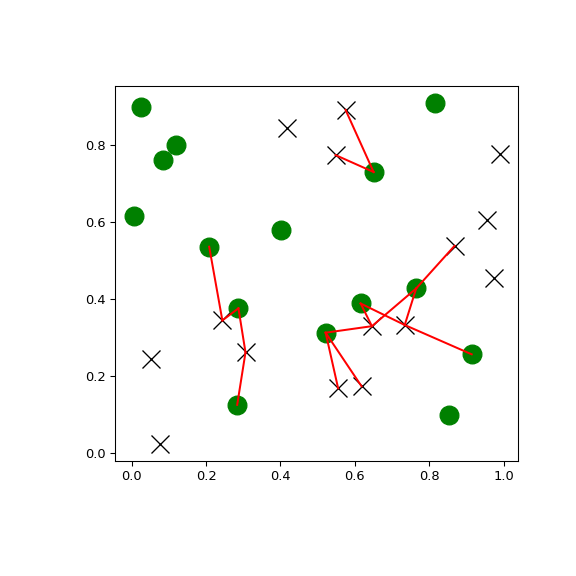scipy.spatial.cKDTree.
query_ball_tree#
- cKDTree.query_ball_tree(self, other, r, p=2., eps=0)#
查找 self 和 other 之间距离至多为 r 的所有点对
- 参数:
- othercKDTree 实例
包含要搜索的点的树。
- rfloat
最大距离,必须为正数。
- pfloat, 可选
要使用的 Minkowski 范数。 p 必须满足条件
1 <= p <= infinity。 如果可能发生溢出,则有限大的 p 可能会导致 ValueError。- epsfloat, 可选
近似搜索。 如果树的分支的最近点距离大于
r/(1+eps),则不会探索这些分支,如果最远点距离小于r * (1+eps),则会批量添加分支。 eps 必须是非负数。
- 返回值:
- results列表的列表
对于此树的每个元素
self.data[i],results[i]是其在other.data中的邻居的索引列表。
示例
您可以在两个 kd 树之间搜索一定距离内的所有点对
>>> import matplotlib.pyplot as plt >>> import numpy as np >>> from scipy.spatial import cKDTree >>> rng = np.random.default_rng() >>> points1 = rng.random((15, 2)) >>> points2 = rng.random((15, 2)) >>> plt.figure(figsize=(6, 6)) >>> plt.plot(points1[:, 0], points1[:, 1], "xk", markersize=14) >>> plt.plot(points2[:, 0], points2[:, 1], "og", markersize=14) >>> kd_tree1 = cKDTree(points1) >>> kd_tree2 = cKDTree(points2) >>> indexes = kd_tree1.query_ball_tree(kd_tree2, r=0.2) >>> for i in range(len(indexes)): ... for j in indexes[i]: ... plt.plot([points1[i, 0], points2[j, 0]], ... [points1[i, 1], points2[j, 1]], "-r") >>> plt.show()
